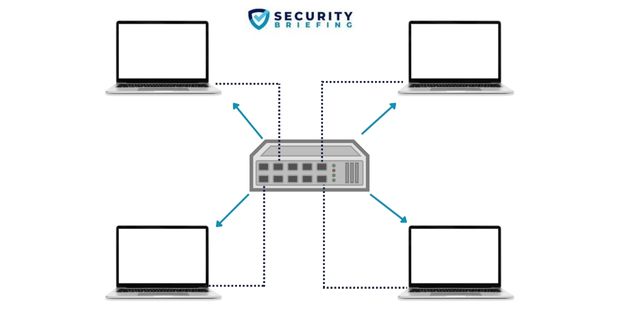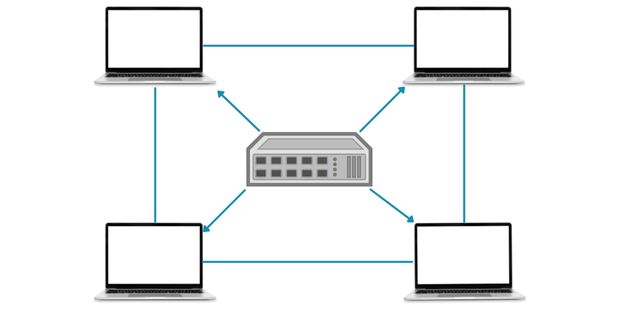Basic Networking: How do Networks Work
November 25, 2022 • security

A network is a system of interconnected devices that exchange information with each other to function correctly. This can include laptops, servers, smartphones, and more. The devices communicate with each over Special networks known as Routers and Switches. As the number of devices connected to the internet continues to grow, we must understand how they communicate with one another. In this article, we will take a look at the different network components and how they work together to allow us to browse the web, send emails, and more.
There are different types of Networks, each with varying extents of coverage. To begin, let’s explore the various types of Networks:
Network Types:
LAN – Local Area Network
A LAN, or Local Area Network, is a smaller network type and is limited to an organization or home. For example, the number of devices connected to your home network is restricted compared to another network type. A school network, even though it is larger than a home network, is still considered a LAN because it interconnects many devices within the same physical space. This includes computers, servers, etc.
MAN – Metropolitan Area Network
MAN is an extended network that covers the entirety of a city.
By combining and connecting multiple networks within a city, we would form a MAN- or metropolitan area network. This type of network is more comprehensive and covers an entire town. A type of network that offers relatively faster data speeds than the average internet connection is called a Metropolitan Area Network, or MAN.
WAN – Wide area Network
A WAN (wide area network) is a large computer network that connects smaller networks, like LANs (local area networks).
A WAN is a network that connects many cities or countries together so that people can use the internet or communicate with each other easily across a large area. When multiple LANs of an organization are interconnected, it forms a WAN.
WWAN
Basically, the internet is a worldwide area network (WWAN).
WLAN – Wireless LAN
A Wireless LAN, or Wi-Fi for short, is a network that’s typically created by our home router.
A WLAN is a type of LAN that we can connect to wirelessly from our smartphones, tablets, laptops, or any other device. The wireless environment, which uses radio waves to transmit data instead of cables or other physical media, has different characteristics than the wired cable-based network in terms of speed, security and coverage. One of the best advantages to wireless connectivity is that it’s very flexible.
In addition to the network types mentioned above, there are other networks of different sizes or purposes. For example,
- SAN- Storage Area Network.
- EPN – Enterprise Private Network.
- VPN – Virtual Private network.
Networks can be represented in two ways:
Networks are typically represented by a “network topology”, which refers to the way devices on the network are connected. There are two main types of network topologies: logical and physical.
Logical topologies
Logical topologies illustrate the logical aspects of a network, such as IP addresses, the connection between devices, and the routing protocols being utilized.
Physical topology
The physical topology of a network is the way in which it is physically arranged. This includes where devices are placed, what type of cables are used, how many ports are needed, and to which ports/switches servers will be connected. The physical topology is a diagram showing the equipment’s location and purpose in the network.
However, the purpose of a device will result in different network topologies.
Network Topologies
There can be multiple ways to represent devices in a network environment. They can be grouped based on their different purposes.
Starlike Topology
The most popular topology used for LANs is the Star Topology. Star topology works best for smaller networks, like those used by small businesses.
For example, if we only need network connectivity or internet access, we can group the devices in a starlike topology. All the machines in this network are connected to the central HUB. If any node fails, it doesn’t harm or damage the entire network because they are very easy to maintain and grade.
However, the problem with this scenario is the lack of redundancy, which is essential for computer networking.

Mesh Topology
A Mesh Topology is best for a reliable network, such as an ISP – Internet Service Provider. With this design, everything is backed up. So if something goes wrong with a cable or switch, there are other ways to access the internet or wherever you’re trying to connect. Remember that full redundancy means you’ll need more devices and longer cables, equating to higher costs. A full Mesh Topology generally costs more to implement than a Starlike Topology.
Some examples of Mesh Topology are Google Wi-Fi, Google Home or Networks in military devices.

Partial Mesh Topology
The Partial Mesh Topology is a more affordable network topology that only provides redundancy for some of the switches and parts of the network. The other switches are left with no alternative paths.
Hub and Spoke Topology
The Hub and Spoke Topology is utilised frequently in the WAN (internet) design. The three routers in this topology are unacquainted with each other by default. So that data will arrive at its destination, both R1 and R3 will have to send their traffic to R2, who knows how to redirect it correctly. For example, if R1 wants to send traffic to R3, they will do it by sending it through the Hub (R2). The Hub then knows how to process and redirect that traffic.
Network components
The pieces that come together to make a network are:
End-device
Any physical device we use to connect to the internet is known as an end device. This includes PCs, laptops, smartphones, servers and more. The connection can be made through multiple channels, such as electricity, light impulses, or radio waves. We can connect to the Internet wirelessly from our smartphones, laptops, and PCs. If we’re using a laptop or PC, we can also use a Network cable (UTP).
Switch
A Switch interconnects multiple end devices, like computers and printers, within a network (LAN).
This device is popular for its ability to handle many ports, with speeds between 1 and 10 Gbps per port. The switch uses MAC addresses to identify the end devices connected to the network. This makes it easy for you to track which devices are connecting to your network and ensures that only authorized devices can access your data.
Router
A router connects multiple smaller networks (LANs) to form one large network (WAN- Wide Area Network). The Router is a device that connects us to the internet by handling packet delivery from any network source to any destination network. The Router uses IP addresses to identify devices sending and receiving data. A Router typically has between 2 to 5 ports, as opposed to a Switch which can have many more. Additionally, both devices have comparable speeds of 100 Mbps- 10 Gbps, depending on the model.
Firewall
We are better equipped to halt possible virtual break-ins by having a firewall.
Transmission medium
The transmission medium is the means by which information is transmitted, e.g. through a cable or wirelessly.
How do computers communicate over the Internet?
Traffic must have a unique identifier to communicate with sites like Facebook and Google. This is called IP or Internet Protocol. IP, or Internet Protocol, is how we identify a device either in a network or on the internet. This number must be unique. You cannot have two identical IP addresses on the same network or the Internet because it will create a conflict, and your connection will not work correctly.
Growth of the Internet
In recent years, the number of connected devices worldwide has exploded. Did you know that in 2020, there were approximately 50 billion devices connected to the internet? And out of those 50 billion devices, an increasingly high number is part of the Internet of Things (IoT).
The Internet of Things (IoT) describes devices that can collect data from each other and use the internet to communicate. Some examples of common IoT devices include sensors, smart home devices, payment terminals and smart wearables. These devices also need to have an IP address.
IP addresses are of two kinds:
Public IP VS Private IP
Public IP addresses
Just as their name suggests, public IP addresses are used for communication over the internet. Organizations like NIC (Network Information Centre) and IANA register public IP addresses, which are then assigned to Internet Service Providers (ISPs) or other groups.
Private IP addresses
Private IP addresses are normally used in Local Area Networks (LANs), like home or school networks. Consequently, Private IP addresses cannot be found on the Internet. In order to allow computers to communicate with one another over the Internet, a protocol was designed known as NAT (Network Address Translation.) This converts private IP addresses into public IPs.
NAT can improve our network’s security by making it difficult for an attacker to access private IP addresses.
In brief
As the number of devices connected to the internet continues to grow, we must understand how they communicate with one another. This article looks at the different network components and how they work together to allow us to browse the web, send emails, and more. We also looked at how IP addresses play a role in identifying devices and why private IPs are used in local area networks. Understanding how these technologies work is more important as we move into an increasingly interconnected world.

security
admin is a senior staff writer for Government Technology. She previously wrote for PYMNTS and The Bay State Banner, and holds a B.A. in creative writing from Carnegie Mellon. She’s based outside Boston.